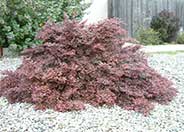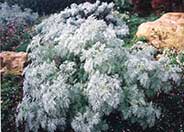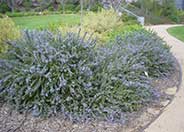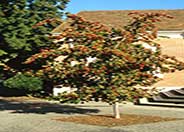

Common name:Red Fringe Flower
Botanical name:Loropetalum chinese 'Rubrum'
Red Fringe Flower is a 6-12' shrub with arching branches and light green and reddish leaves .

Common name:Silver Mound Artemisia
Botanical name:Artemisia schmidtiana 'Silver Mound'
This mounding perennial will grow 1-3' high and has medium-sized silvery white leaves with yellow and white flowers.

Common name:Japanese Maple
Botanical name:Acer palmatum
This magnificent plant can used as a small tree or shrub. It is deciduous with graceful leaves which have a scarlet color in spring as it leafs out. They turn orange or yellow in fall. It is slow growing to 20', and requires shelter from hot winds. The leaves of this tree are small, light green in color, and deply lobed. It should also be noted that the tree remains spectacular throughout all seasons. Second picture by Steve Mullany.

Common name:Prostrate Rosemary
Botanical name:Rosmarinus officinalis 'Prostratus'
The 'Prostratus' grows to a height of 2-3' with a spread to 8'. Its flowers are pale, lavender-blue in color, and the leaves are needle-like with a dark, blue-green color. This plant makes a good ground cover, and its leaves can be used as seasoning in cooking.

Common name:Licorice Plant
Botanical name:Helichrysum petiolare
This groundcover will grow 1'-3' high and has clumped light green leaves. It does well in full sun and dry soil.

Common name:Washington Thorn
Botanical name:Crataegus phaenopyrum
A deciduous tree that grows to a height of 20' tall and wide, glossy leaves 2-3" long with 3-5 pointed leaves are part of the growth. In the spring, small white clusters of flowers will appear. Fruit of a shiny red color will remain well into winter.
More than half of the water used at your home is for outside purposes. Studies show that on average, half of the water used outdoors is wasted. The leading cause of waste is incorrectly set and poorly managed irrigation controllers. The second biggest cause of wastage is broken irrigation equipment that goes undetected. There are a few basic things you can do to make a big difference in your water use.
Click in the green box for more information
| Designer: | View From Sidewalk |
Photographer: GardenSoft |
Practice grass-cycling by leaving short grass clippings on lawns after mowing, so that nutrients and organic matter are returned to the soil.
Adjust sprinklers to avoid watering sidewalks and driveways.
Attract, or buy beneficial insects such as ladybugs and lacewings to control pest outbreaks in your garden.